Charity Begins at Home
Our neighbors are some amazing people. They do not take for granted the privilege of living in Chesapeake Country in comfort and community amidst a larger world where so many suffer famine, flood, fighting and so many degrees of inferiority.
They interpret that privilege as a challenge to make a better world. Rich in resources as we are, many of us take that challenge far and wide. Others find their mission here at home — for even here, good fortune is not equally distributed.
This week, as the season of Thanksgiving flows into the season of giving, we introduce you to a half-dozen ways our neighbors use what they do best to improve the quality of life throughout Chesapeake Country.
Some of these stories on local charities are written from the inside, by people who know they’re getting as much as they give. Others are written from the outside, by Bay Weekly reporters awed by how generosity flows through us like our rivers.
Reading these stories, you’ll share in the flow.
Annapolis Quilt Guild
I pay my rent by stitching
by Prue Hoppin, retired career counselor and coach
“Service to others is the rent you pay for your room here on earth,” said activist and heavy-weight boxing champion Muhammad Ali.
I pay my rent by stitching.
It is Thursday, and friends and I have gathered to enjoy the companionship and joy that comes from working together, sharing a common purpose. We have sewing tables, scissors, pins, patterns, fabric and ample amounts of coffee and chocolate.
We are quilters. We love color, the feel of fabric, the endless patterns and possibilities. We love uninterrupted hours of cutting and sewing that feeds our passion for stitching. We also share a strong commitment to outreach by making quilts that provide warmth and comfort for those in need.
The quilts we make, as well as those made by other members of the Annapolis Quilt Guild, are for the Light House, a shelter providing housing and support services for the homeless in the Annapolis area. Our goal is to keep a quilt on each of the shelter’s beds and to provide quilts to grace the walls and hallways, sending a message of welcome, safety and home. My role is encouraging donations, organizing sewing days and coordinating with Light House staff. The Guild has donated 150 quilts to the Light House over the last two years, in addition to many quilts to other local organizations.
Given our love of handwork, it isn’t surprising that many Guild members also sew, knit and crochet. Those talents are tapped through other outreach projects: pillows, baby hats and mittens, receiving blankets and small stuffed bears for the Anne Arundel Medical Center; drawstring bags for Beads of Courage; and quilted gift bags for hospitals.
My first stitches were on a toy sewing machine; then came a sewing class at the Y as a teen and casual dress-making on a real machine. I loved the time I spent being completely absorbed in a creative project. I savored the quiet, restorative hours and delighted in the final, useful products. However, during the years of career and family building, fabric grew dusty and the machine sat unused.
Searching for new meaning and purpose in later years, I came across Richard Bolles’ essay on finding mission in life. His formula? Use the skills that give you the most joy and energy, in ways that appeal to you the most, to meet needs in the world. It became clear: I would sew and quilt for others. I jumped in: stuffed animals and receiving blankets for hospitals and then the quilts, which have been my focus for the past 15 years.
Perhaps I could have predicted this outcome. I always loved sewing; and my mother and grandmother spent years using needle and thread to support non-profits. I’m simply following in the footsteps of women who paid their rent by stitching. And in the Guild, I am surrounded by others who do the same.
Annapolis Quilt Guild is a creative guild of almost 300 members whose interests range from traditional to modern and skills from accomplished to novice. All are welcome. Monthly Monday meetings (typically, the first Monday), 7-9pm at St. Philip’s Episcopal Church, Annapolis. http://annapolisquiltguild.org
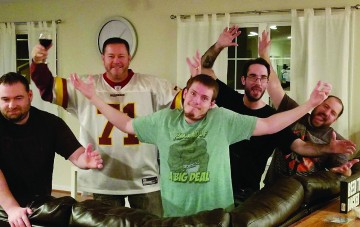
The Autism Project
Hundreds find help in one woman’s mission
by Jen Rigdon Teter
Angela Gaither-Parker found her future in the help-wanted ads. A mother sought a person trained in a particular therapy technique to work part-time with her daughter, who had autism, a condition that affects an individual’s ability to communicate and interact. Gaither-Parker, a new college graduate, had learned about the technique in a psychology class. She answered the ad.
Fifty people applied, but the mother chose Gaither-Parker, hiring a consultant to train her further in the therapy so she could more effectively help her daughter.
Gaither-Parker so enjoyed working with the little girl that she took on other students with autism. Then came an epiphany: Instead of going from house to house and working one-on-one with each child, she could bring the kids together in one place so she could teach them to interact. She started facilitating playgroups for her students out of her parents’ small guesthouse in Calvert County. Over the next several years, as the playgroups stretched to six days a week, the small house became too small.
She found just the right space, where her students could play outside, in rural Owings. There are rooms for work and play, a kitchen, exercise room, playground, therapeutic swimming pool and a clubhouse for teen and young adult students. Along the way, Gaither-Parker — whose students know her as Miss Angel — opened The Autism Project as a 501(c)(3) charitable organization, earned a masters degree in special education and a graduate certificate in educating students with autism.
She broadened her offerings and hired more staff. Today, The Autism Project serves 90 students from Calvert and surrounding counties, offering individual therapy, social skills groups, summer camp and programs for parents and siblings. Group activities are arranged by age and ability level. There is an independent living home for adults with autism and plans to open a second such home.
Every spring, students help with the annual bake sale. They gain everyday life skills by learning to work together, read recipes, measure ingredients, bake and clean up, all while being safe in the kitchen. Learning to interact with customers at the sale is another life skill. Even students whose abilities are currently more limited are able to contribute to the bake sale by labeling packages and wrapping coins for deposit.
Instead of the single therapy that got her started, Gaither-Parker now uses multiple treatment approaches to best meet the needs of each individual, with special attention to learning everyday life skills.
“My son has made incredible strides since beginning therapy at The Autism Project,” one parent said. “Every week his face lights up when told It’s time to go see Miss Angel!”
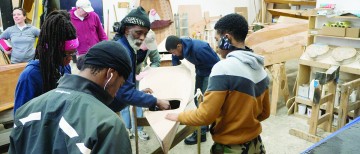
Box of Rain
Turning tragedy into triumph
by Debbie Brown Driscoll
On September 19, 2002, Annapolitan Lee Griffin was shot and killed as he unloaded groceries in front of his home. The perpetrator was a 21-year-old African American male.
Lee’s friend Anne Harrington was devastated and angry. Yet less than a year later, she and others in her circle would turn their pain into pride, introducing a program that would be not only a living legacy honoring Griffin but also a force in the lives of disadvantaged children.
In June 2003, Box of Rain launched its first seven-week summer sailing program for children. The sport was chosen because Lee Griffin was an avid sailor; the name because Box of Rain was his boat.
In 14 years, more than 500 at-risk youth sailed, built boats, exercised and had fun on the way to growing up productive and well adjusted.
“These kids are enjoying things they’d never have the opportunity to otherwise,” says executive director Karen Colburn. “I watch most of them come in with no self-esteem or sense of worth and quickly blossom into self-confident, successful kids, ready to take on the world.”
Box of Rain has grown from a summer maritime program to year-round enrichment for kids. An advisory board of professionals helped develop activities to keep kids engaged.
After-school programs provide attention and encouragement, physical activity, opportunities to build social skills and access to technology, which most don’t have at home. In addition, there is boat-building in the winter and special fitness courses in the spring.
Colburn says. “Sometimes, all they really need is an ear to listen to them, or a pat on the back and an encouraging word.”
Charting Careers works to help high-schoolers learn to manage finances, interview for a job and work toward college.
Parents as Partners involves parents, providing regular updates on their children and attempting to solve issues of transportation and internet access.
The success stories are countless, with graduates going on to college, nursing school, good jobs and healthy relationships.
Among them is graduate Tykiara Chew, who grew up in public housing. After joining Box of Rain in middle school, she quickly advanced to paid summer counselor and eventually to program assistant, whose job is reaching out to the families of Box of Rain’s 50 kids.
A graduate of the Charting Careers program, she starts nursing school in January.
Box of Rain is a 501(c)3 organization offering year-round programming to inspire and encourage Annapolis area youth, especially from disadvantaged circumstances. Box of Rain’s focus on mentoring builds self-esteem and helps kids develop life skills and earn a sense of accomplishment that leads to positive contributions to the community. Box of Rain depends on contributions and welcomes donations and volunteers: www.boxofrainannapolis.org.
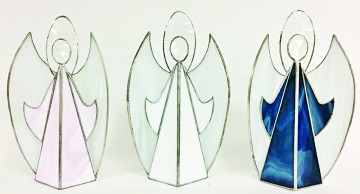
The Caring Collection
Helping has, I hope, made me a better person
by Marion A. Kay, 10-year volunteer
About a decade ago, I found myself with extra time on my hands. I wanted to do something that would be fun and maybe even rewarding at the same time. A newspaper article about an open house at the Caring Collection showed a picture of a group of cheerful-looking ladies.
The Caring Collection was looking for volunteers, and I called.
Director Bobbie Burnett, the Annapolis artist who started the nonprofit nearly 25 years before, told me more about their work and invited me to visit her home studio on a day volunteers were working.
The Caring Collection was housed in a bright, spacious room in the basement of Bobbie’s home. Prominently displayed on glass shelves around the room were displays of stained glass angels. Suncatchers, another popular product, were also on display. Several volunteers, mostly women my age, were tracing patterns on glass, cleaning glass, counting cut-out pieces, answering the phone and writing up phone orders. These were things I could do; maybe later I could learn the more skilled jobs such as cutting, grinding, foiling and soldering the pieces together.
I decided to go to the studio every week and become part of this wonderful group. I not only met new people but also learned a few skills involved in working with glass.
Several times a year, Bobbie and her late husband Jerry organized wonderful parties for volunteers and their spouses. I felt I was part of a larger family of very important people. Another proud moment came every spring when I attended the annual Donation Day, when doctors and administrators from Johns Hopkins and Anne Arundel hospitals came to visit, explain their work and let us know how much they appreciated our efforts. I also toured the hospitals and saw the equipment we had funded.
Volunteering with Caring Collection has given me the opportunity to help those in need, which I hope has made me a better person.
The Caring Connection hand-crafts and sells stained-glass angels and sun catchers to raise funds for treating cancer patients at Anne Arundel Medical Center and Johns Hopkins Hospital.
In 35 years, the nonprofit — begun with a single angel made to honor a friend — has created 45,000 angels and raised more than $1.2 million.
This year’s, creation, the Caring Angel, will be the last, says Burnett. The 10-inch-tall three-dimensional angels, robed in pink, white or blue, sell for $250: www.caringcollection.org.
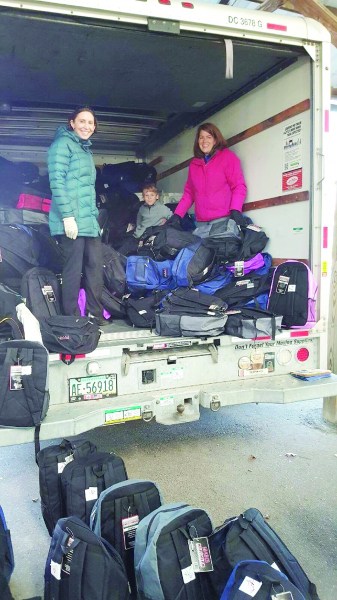
Giving Back, Linda’s Legacy
For Jeanette Middleton Sudano, Linda’s Legacy is also Nathan’s legacy
by Diana Dinsick
As a 17-year volunteer for Giving Back, Linda’s Legacy, Jeanette Middleton Sudano, of Severna Park, knew something of the daily struggles of people who are homeless. Nathan McDavitt, her then nine-year-old son, got his first glimpse into the lives of the needy on Christmas Eve 2002, when he accompanied his mother to the Giving Back Christmas holiday drive in Annapolis.
“It made quite an impression,” says Sudano. “The next morning — Christmas morning — Nate wanted to donate his own gifts to charity.”
From that year onward, the Giving Back, Linda’s Legacy holiday drive became their annual tradition. Some years, they worked Christmas week at the Anne Arundel County Farmer’s Market on Riva Road in Annapolis, boxing donations of warm clothing and toiletries, then loading them into U-Hauls for distribution. As a teen, Nathan and his mother also took to the streets and homeless shelters in Anne Arundel County, Baltimore and Washington, D.C., to deliver directly to people in need.
One snowy Christmas Eve, when they met a homeless man wearing flip-flops, Nathan gave him the boots off his feet.
This was typical of Nathan, Sudano says. In generosity, he mirrored the Giving Back founder Linda Greenberg, who as a child had given her coat to a homeless man.
After finishing his Associate’s Degree through Anne Arundel Community College, Nathan enlisted in the Air Force. On December 30, 2015, following his basic training, Airman First Class Nathaniel H. McDavitt married Airman First Class Alexis Jaden Miller. One month later, he deployed to Jordan.
Four months later, the family was notified that Nathan had been critically injured in Jordan during the collapse of a temporary airplane hangar. His parents and wife flew there, and all three were at his side on April 15, 2016, when he died.
It was a heavy blow. Still, as she struggled through her grief, Sudano vowed to carry on the giving tradition she shared with Nathan.
In October of 2016, backed with the support of husband Sam Sudano and their twins Harrison and Olivia, Jeanette Middleton Sudano became the executive director of Giving Back, Linda’s Legacy, replacing founder Linda Greenberg, who had died the previous year. That Christmas Eve, as many as 600 volunteers of all ages appeared at the Farmers’ Market, where they boxed and loaded 27 U-Hauls with donated items for distribution. All told, the charity gave out 1,732 bag lunches, 400 cakes and 3,000 backpacks filled with toiletries, thermal underwear, hats, scarves, gloves and socks. They hope to do as well — or better — in the coming year.
Giving Back, Linda’s Legacy is now ramping into high gear for the 2017 holiday season. Volunteers will still visit the streets on Christmas Eve.
As Sudano explains, “Nathan and I loved doing this together. There is nowhere else I’m going to be on Christmas Eve.”
Additional donations will be sorted and packed at the Farmers’ Market on December 26, 27 and 28, then delivered to shelters on December 29.
You too can give your time, or donate new or gently used clothing, hats, outerwear, gloves, socks and boots for all ages and gender. Also needed are travel-sized toiletries, new thermals, toys and baby items, non-perishable foods, cakes and signed holiday cards.
For donation sites and volunteer opportunities:
www.facebook.com/GivingBackLL/?fref=ts and www.homelessdrive.org/new-events
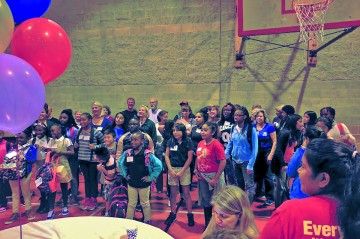
Seeds 4 Success
Earning my space on the planet
by Marguerite Welch, Tutor
Fourteen years sailing around the world in a small boat with the same man had been a challenge. But now it was over. I felt rudderless: without a destination, without a challenge, without a plan.
Many times along the way I had been struck by the hedonism of our voyage when confronted with the poverty, lack of education and opportunities that limit the lives of so many people in the world.
Better angels whispered, What the heck are you doing to earn your space on the planet?
Bingo. Through a circuitous path of friends, seeds were planted in my life, as in Seeds 4 Success, a local tutoring and mentoring program for underserved children living in public or subsidized housing. Here in my own hometown was a whole world of need that I had always known about but never personally confronted. I signed on, clueless as to where this new journey would take me.
Driving to the Eastport Community Center that first day felt like approaching a foreign port in a thunderstorm. It had been 40 years since I struggled through math word problems, multiplication tables, lost homework and bored, fidgety kids. Pulling into the lot, I realized I was in unfamiliar territory. Sure, I had driven through Eastport a million times — but never down Madison Street. My heartbeat accelerated as I locked the car and walked to the Zone, where the Eastport Girls Club section of Seeds met every Wednesday after school.
All the girls were paired with tutors, and, for the most part, heads were bent over homework.
One small girl in the corner sat staring at her desk, long black hair hiding her face.
The director introduced me as Ms. Marguerite, your new tutor. Estelle stared at her desk. Hello, I said, holding out my hand. Estelle mumbled Hello and stuck out her hand but did not look up.
Hmmm. She’s as nervous as I am.
I knelt down so I could see her face and said, I’m so happy to meet you. What would you like to work on today?
She shoved a book toward me. Reading, she whispered. I was so glad it wasn’t math.
Over the ensuing weeks we relaxed, feeling more comfortable in each other’s company. Until the big science project — every parent’s nightmare — complicated by Estelle’s weak language skills and my weak science background. I suggested a navigation project, which quickly got too complicated for both of us.
Online I found simple instructions on building a catapult out of popsicle sticks to demonstrate Newton’s laws of objects in motion, which we were studying in science class.
As the deadline loomed, we met at the middle school to work out the project, build the catapult and compare how far it would send objects of different sizes and weights. It must have been quite a sight: one 75-year-old grandmother squatting on the floor with her fifth-grade friend hurling paper balls and pebbles down the hallway, giggling as teachers, janitors and after-school kids dodged our missiles.
It’s for science, we said, bent with laughter.
Years later, high-schooler Estelle raptly described to me the dissection of a shark’s eye. A science major launched by a catapult, I thought.
In 2008, members of the Eastport community grew concerned about crime in nearby Annapolis public housing communities and the safety of children living there. Seven women started Seeds 4 Success and discovered the barriers facing children growing up in multi-generational poverty. Incorporated in 2012 as Seeds 4 Success, Inc. (S4S), this professional nonprofit organization has a staff of six and more than 60 volunteers to address unmet needs and gaps in youth development: academic skills particularly in STEM, mentoring, learning and enrichment, vocational and career-focused training, transportation access, parenting skills and family support. The mission is helping children from low-income communities succeed in school and life: www.s4sannapolis.org/en
